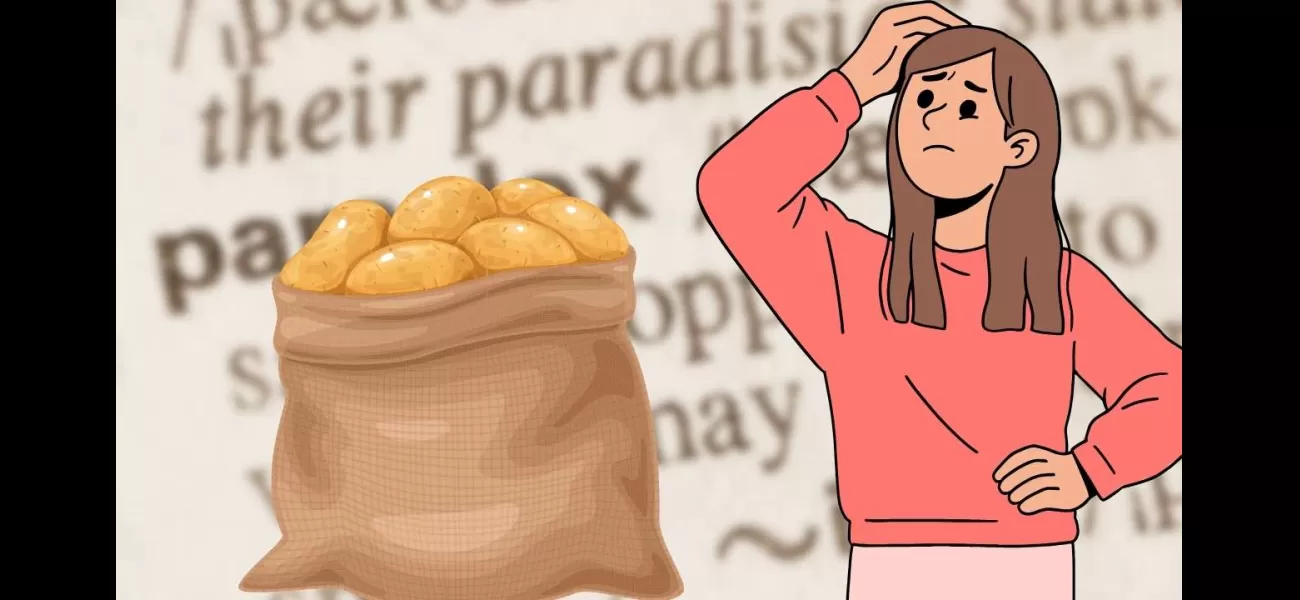Can a potato be cut into two pieces and then reassembled to make two whole potatoes?
The potato paradox is a mathematical puzzle where 100kg of potatoes with 99% water, after drying and now 98% water, pose the question of their revised weight.
February 22nd 2024.

The potato paradox is a thought-provoking mathematical puzzle that has puzzled many for years. It all starts with a man named Fred, who buys 100 kg of potatoes that are said to contain 99% water. But after some time, the potatoes are left to dry and their water content reduces to 98%. The question that arises is: what is the new weight of the potatoes?
At first glance, this may seem like a straightforward question. However, as the name suggests, the potato paradox is far from simple. In fact, the answer is quite the opposite of what most people would expect. It is known as a veridical paradox, which means that a seemingly impossible or contradictory situation turns out to be true.
This tricky paradox has been featured in The Universal Book of Mathematics and has left many scratching their heads. The surprising answer to the question is 50 kg. If this has you puzzled, let's take a closer look at how this solution is reached.
To understand the potato paradox, we must first understand that 99% of the potatoes' weight is made up of water. This means that the remaining 1% is the dry mass, which remains constant at 1 kg even after the water evaporates. In order to achieve a water content of 98%, the dry mass must now make up 2% of the total weight. This means that it has effectively doubled in proportion. But with the dry mass remaining at 1 kg, the only way to achieve this is by reducing the total mass of the potatoes.
Therefore, to double the proportion of dry mass, the total mass of the potatoes must be halved, resulting in a final weight of 50 kg. This may seem counterintuitive, but it is the only logical explanation.
To break down the mathematical solution, let's use some variables. Let represent the new total mass of the potatoes, represent the dry mass, and represent the mass of water. Since the water content is 98%, we can write the equation .
From this, we can see that the total mass equals the sum of the dry mass and the mass of water, which can be written as . Solving for , we find that the new total mass of the potatoes is 50 kg.
The potato paradox has gained recognition in popular culture, making appearances on the Car Talk radio show and being acknowledged as one of the "Five Famous Paradoxes." Its puzzling nature continues to amaze and intrigue mathematicians and non-mathematicians alike. So, the next time you come across a bag of potatoes, you may want to take a moment to appreciate the hidden math behind them.
At first glance, this may seem like a straightforward question. However, as the name suggests, the potato paradox is far from simple. In fact, the answer is quite the opposite of what most people would expect. It is known as a veridical paradox, which means that a seemingly impossible or contradictory situation turns out to be true.
This tricky paradox has been featured in The Universal Book of Mathematics and has left many scratching their heads. The surprising answer to the question is 50 kg. If this has you puzzled, let's take a closer look at how this solution is reached.
To understand the potato paradox, we must first understand that 99% of the potatoes' weight is made up of water. This means that the remaining 1% is the dry mass, which remains constant at 1 kg even after the water evaporates. In order to achieve a water content of 98%, the dry mass must now make up 2% of the total weight. This means that it has effectively doubled in proportion. But with the dry mass remaining at 1 kg, the only way to achieve this is by reducing the total mass of the potatoes.
Therefore, to double the proportion of dry mass, the total mass of the potatoes must be halved, resulting in a final weight of 50 kg. This may seem counterintuitive, but it is the only logical explanation.
To break down the mathematical solution, let's use some variables. Let represent the new total mass of the potatoes, represent the dry mass, and represent the mass of water. Since the water content is 98%, we can write the equation .
From this, we can see that the total mass equals the sum of the dry mass and the mass of water, which can be written as . Solving for , we find that the new total mass of the potatoes is 50 kg.
The potato paradox has gained recognition in popular culture, making appearances on the Car Talk radio show and being acknowledged as one of the "Five Famous Paradoxes." Its puzzling nature continues to amaze and intrigue mathematicians and non-mathematicians alike. So, the next time you come across a bag of potatoes, you may want to take a moment to appreciate the hidden math behind them.
[This article has been trending online recently and has been generated with AI. Your feed is customized.]
[Generative AI is experimental.]
0
0
Submit Comment





